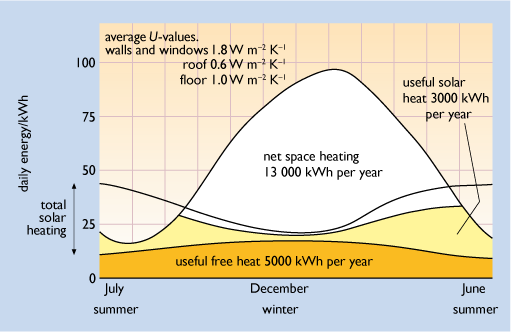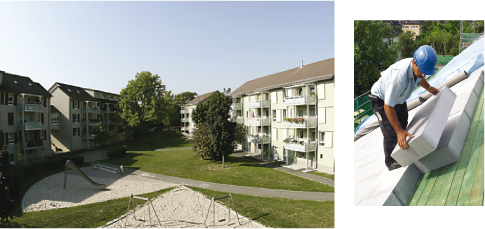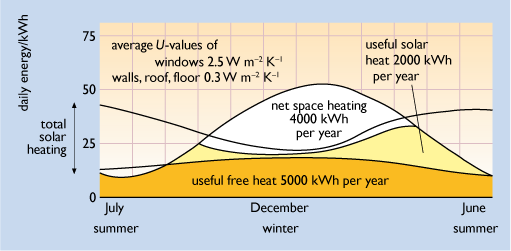2.4.4 Improving insulation standards
By the standards of the whole British housing stock the heat loss coefficient for the sample house of 127 W K–1 calculated above is quite good. In 2011, the average British dwelling had an estimated heat loss of about 290 W K–1 down nearly a quarter on the figure of 376 W K–1 for 1970 (BEIS, 2013).
How do these improving insulation standards affect the total amount of heat that a space heating system must supply?
Figure 24 shows the estimated gross heating demand of a poorly insulated 1970s UK house (similar houses will be found right across Northern and Central Europe). This peaks at nearly 100 kWh per day in midwinter.

This heating demand will be higher in the cold midwinter months than in the warmer spring and autumn ones. In summer, when the outside air temperature is high, this gross heating requirement falls to under 20 kWh per day. Free heat gains are likely to contribute throughout the year, peaking slightly in midwinter when there is most artificial lighting use. Solar gains are likely to give most contribution in autumn and spring. Not all of the solar gains will be useful in heating the house; some are likely to cause overheating and the occupants may open the windows to dissipate any surplus gains.
For this particular house, over a whole year, out of a total gross heating demand of 21 000 kWh, 5000 kWh have come from free heat gains and 3000 kWh from solar gains. Put another way, in this perfectly ordinary house 14% of the gross heating demand is supplied by solar gains. The net space heating demand, to be supplied by the normal heating system, is the remaining heat requirement, 13 000 kWh. This will have to be supplied over a ‘heating season’ from mid-September to the end of May.
Figure 25 shows the gross and net space heating demands over the year for a more modern house with a better standard of insulation, including double-glazing and insulated walls, floor and roof. The gross heating demand now peaks at just over 50 kWh per day in midwinter. Over the whole year it has been roughly halved to about 11 000 kWh, but now the free heat and solar gains are sufficient to keep the house at a comfortable temperature for more of the year. The heating season is now shorter, only from October to April and the net space heating demand has fallen to only 4000 kWh, a reduction of 70%.
Passivhaus design
If a house were sufficiently well-insulated – super-insulated – the free heat and solar gains alone should be sufficient to keep the internal spaces warm in all except the very coldest weather. A ‘space heating system’ as such might be very small, or even unnecessary.
It might be thought that as energy efficiency standards improve the level of free heat gains in houses might be likely to fall. However, over the past 40 years the delivered energy per UK household for cooking, lights and appliances has actually risen by about 30%. This trend is discussed later in Section 4.
Super-insulated building design has been heavily promoted in Germany, both for new construction and, most important, the refurbishment of existing buildings. In the late 1990s an estate of apartment blocks in Ludwigshafen in south-west Germany, originally constructed in the 1950s, was given a thorough thermal modernisation (see Figure 26(a)) including:
- at least 200 mm of foam insulation on the roof and in the walls (see Figure 26(b))
- triple-glazed windows with low-e glass with a U-value of 0.8 W m–2 K–1
- mechanical ventilation with heat recovery
- a combined heat and power (CHP) unit (effectively a small power station) using a fuel cell. This technology is described later in section 3.4.

Monitoring showed that the net space heating energy use fell by a factor of seven from 210 kWh per square metre of floor area per year to only 30 kWh m2 yr–1. This is equivalent to 3 litres of heating oil – hence the project name, the ‘3-Liter-Haus’ (IKZ, 2014). Subsequent projects have used even thicker insulation.
The German Passivhaus programme has halved this energy target to 15 kWh m–2 yr-1 using fabric U-values of approximately 0.1 W m–2 K–1. The German climate is colder than that of most of the UK. The house is considered ‘passive’ in the sense that it does not need substantial heating. Such a target would mean a net space heating demand of under 1500 kWh yr−1 for our sample house with a 96 m2 floor area.
In the UK Passivhaus design is being promoted by Passivhaus Trust and their introductory guide [Tip: hold Ctrl and click a link to open it in a new tab. (Hide tip)] includes various housing examples.
Activity 11
In 2015 there were 27 million homes in the UK and their average space heating demand was about 9 000 kWh yr-1. In a home insulated to a Passivhaus standard this could be reduced to only 1500 kWh yr-1.
- a.Calculate the total 2015 UK domestic space heating demand in petajoules (you will need to look back to Box 1 in Section 1 for the conversion factors).
- b.What would the national domestic space heating demand become, in petajoules, if the whole UK housing stock were insulated to a Passivhaus standard. Would you consider the potential energy saving significant given the overall national energy use shown in Figure 1 in Section 1?
Answer
- a.From Box 1, 1 kWh = 3.6 MJ
For each home, annual space heating demand
= 9000 kWh = 3.6 × 9000 MJ = 32 400 MJ = 32.4 GJ
National domestic space heating demand = 32.4 × 27 000 000 GJ
= 874 800 000 GJ = 874.8 PJ
- b.For a Passivhaus home, annual space heating demand
= 1500 kWh = 3.6 × 1500 = 5400 MJ = 5.4 GJ
National domestic space heating demand = 5.4 × 27 000 000 GJ
= 145 800 000 GJ = 145.8 PJ
Saving = 874.8 – 145.8 PJ = 729 PJ
Figure 1 shows a total delivered energy consumption of about 5700 PJ of which over 2000 PJ are devoted to space and water heating. So a saving of over 700 PJ would indeed be significant.

